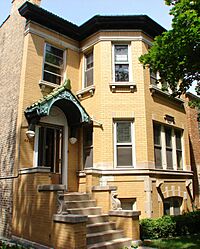Portage Park, Chicago facts for kids
Quick facts for kids
Portage Park
|
|
|---|---|
| Community Area 15 - Portage Park | |
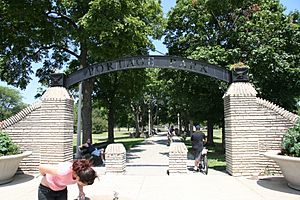
The southwestern entrance into Portage Park at the intersection of Irving Park Road and Central Avenue
|
|
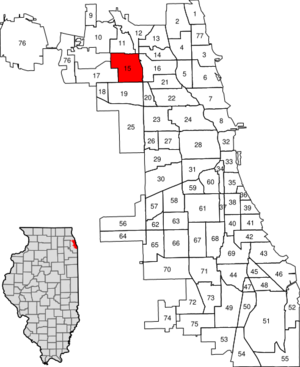
Location within the city of Chicago
|
|
| Country | United States |
| State | Illinois |
| County | Cook |
| City | Chicago |
| Neighborhoods | |
| Area | |
| • Total | 3.98 sq mi (10.31 km2) |
| Population
(2020)
|
|
| • Total | 63,020 |
| • Density | 15,831/sq mi (6,113/km2) |
| Demographics 2018 | |
| • White | 49% |
| • Black | 1.41% |
| • Hispanic | 41.57% |
| • Asian | 5.42% |
| • Other | 2.61% |
| Time zone | UTC-6 (CST) |
| • Summer (DST) | UTC-5 (CDT) |
| ZIP Codes |
parts of 60630, 60634, 60641
|
| Median household income 2018 | $66,309 |
| Source: U.S. Census, Record Information Services | |
Portage Park is a lively neighborhood on the northwest side of Chicago, Illinois. It is one of Chicago's 77 official community areas. Portage Park shares borders with other areas like Jefferson Park to the north and Irving Park to the east.
This area is famous for its "Six Corners" shopping district. This busy spot is where Irving Park Road, Cicero Avenue, and Milwaukee Avenue meet. Portage Park is also known for the Portage Theater and its main park, Portage Park. The name "Portage" comes from an old path that connected the Des Plaines and Chicago rivers. Long ago, this area was so wet that Native Americans and trappers could paddle their canoes through it easily.
Portage Park has the largest Polish community in the Chicago area. You can find many Polish shops and businesses here. There are also Polish organizations like the Polish American Association. One of the parks, Chopin Park, is named after Frédéric Chopin. He was a very famous Polish pianist and composer.
Contents
History of Portage Park
In 1850, a town called Jefferson Township was formed. This happened when the Northwest Plank Road (now Milwaukee Avenue) was built. In 1889, Jefferson Township became part of Chicago. This was before the big World's Columbian Exposition event.
In the early 1900s, much of the area was still like the countryside. But then, streetcar lines were extended along Milwaukee, Irving, and Cicero avenues. This brought many immigrants from crowded city areas. Families from Scandinavia, Germany, Italy, Poland, and Ireland moved here. They bought land to build their homes. Developers like Szajkowski and Schorsch turned farmland into new neighborhoods. These areas became part of Chicago's famous "bungalow belt" with many unique homes.
Population Growth
| Historical population | |||
|---|---|---|---|
| Census | Pop. | %± | |
| 1930 | 64,203 | — | |
| 1940 | 66,357 | 3.4% | |
| 1950 | 64,736 | −2.4% | |
| 1960 | 65,925 | 1.8% | |
| 1970 | 63,626 | −3.5% | |
| 1980 | 57,349 | −9.9% | |
| 1990 | 56,513 | −1.5% | |
| 2000 | 65,335 | 15.6% | |
| 2010 | 64,124 | −1.9% | |
| 2020 | 63,020 | −1.7% | |
| U.S. Decennial Census 2018 US Census American Community Survey | |||
The population of Portage Park has changed over the years. The numbers above show how many people have lived in the area during different census years. This helps us understand how the community has grown and changed.
Getting Around Portage Park
It's easy to get around Portage Park using public transportation. The Blue Line train has stations nearby. The Montrose and Irving Park stations are both close to the neighborhood. These stations are located in the middle of the Kennedy Expressway.
The Milwaukee District / North Line commuter train also has a stop at Mayfair. This station is just west of the Kennedy Expressway.
Exploring the Neighborhood
Portage Park is mostly a place where people live. You'll see many bungalows and two-flat homes here. There are two main shopping areas. One is the "Six Corners" area at Irving, Cicero, and Milwaukee. The other is at Belmont and Central avenues.
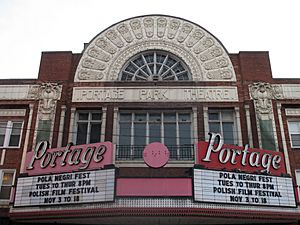
The area used to have several grand movie palaces. These included the Portage, Patio, and Belpark theaters. The Belpark is now closed. However, the Portage Theater has been updated and is now a performing arts center. It shows special arthouse and silent films. The Patio was also restored by private owners. It now hosts music and theater shows.
Portage Park also has many beautiful churches. Their tall spires and steeples stand out in the neighborhood. These buildings add a lot of charm to the area. Some famous ones include St. Ladislaus and St. Bartholomew.
Portage Park: The Green Heart of the Community
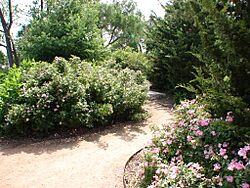
Portage Park is more than just a park. It's the central spot that brought the different parts of the community together. It helped create the neighborhood we know today.
The main building in the park, called the field house, was designed by Clarence Hatzfeld. His company also designed many of the unique "Prairie" and "Craftsman-style" bungalows nearby.
The park once had a pond that connected to a concrete swimming pool. The hill you see east of the pool today was made from the dirt dug out when the pool was first built. The earliest building in the park is the gymnasium. The field house came later.
The WPA helped build the "Rock House" at the south end of the park. This building had a small pond with goldfish and flower beds. The Rock House was made of flagstone, with stone walls, seats, and pillars. The Chicago Park District has old photos of this structure. The park itself was created before most of the buildings around it.
Portage Park's second swimming pool was very important. It hosted the swimming events for the Pan-American Games in 1959. It was also where the U.S. swimming team tried out for the 1972 Summer Olympics.
Other Parks in the Area
Besides the main Portage Park, the neighborhood has other green spaces for everyone to enjoy:
- Chopin Park
- Dickinson Park
- Dunham Park
- Grace Zwiefka-Thuis Playlot Park
- Lucy Gonzales-Parsons Playlot Park
- Wilson Park
Education in Portage Park
Students in Portage Park attend Chicago Public Schools. These schools offer choices for students living in the neighborhood and across the city. There are also private schools run by Catholic and Lutheran churches in the area.
Public Elementary Schools
- Peter A. Reinberg Elementary
- Chicago Academy Elementary
- William P. Gray Elementary
- Portage Park Elementary School
- Prussing Elementary School
- Smyser Elementary School
Public High Schools
- Edwin G. Foreman High School
- Carl Schurz High School
- Rickover Naval Academy School
Private Elementary Schools
- St. John's Lutheran School
- Midwestern Christian Academy
- Pope Francis Global Academy
- St. Robert Bellarmine
Private High Schools
- St. Patrick High School
Public Libraries
The Chicago Public Library has three branches in the Portage Park community area. These are the Portage-Cragin, Austin-Irving, and Jefferson Park branches. They offer books, computers, and programs for all ages.
Culture and Community
- The Patio Theater, built in 1927, is a single-screen theater. It shows classic and independent films.
- There are plans to put a statue of the famous pianist Frédéric Chopin in Chopin Park. This would celebrate the 200th anniversary of his birth.
- Portage Park was the childhood home of Francis Cardinal George. He was a very important religious leader in Chicago. A street near Byron Street is named after him.


